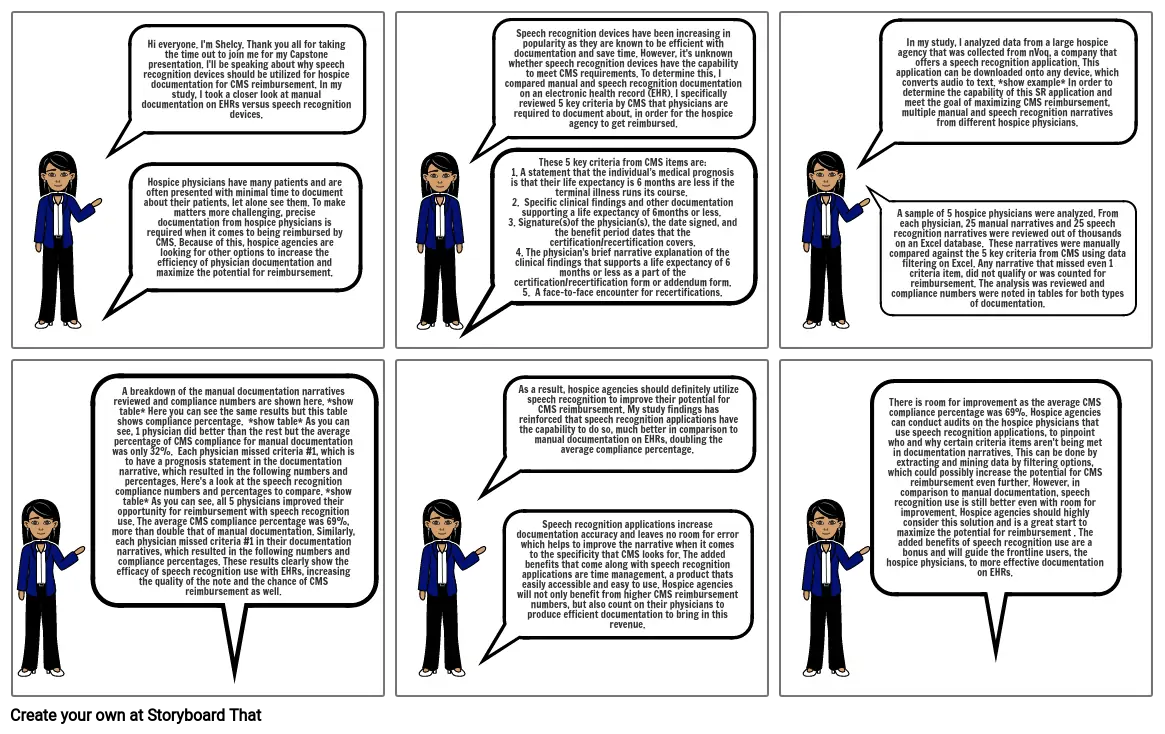Capstone Storyboard

Storyboard Text
- Hospice physicians have many patients and are often presented with minimal time to document about their patients, let alone see them. To make matters more challenging, precise documentation from hospice physicians is required when it comes to being reimbursed by CMS. Because of this, hospice agencies are looking for other options to increase the efficiency of physician documentation and maximize the potential for reimbursement.
- Hi everyone. I'm Shelcy. Thank you all for taking the time out to join me for my Capstone presentation. l'll be speaking about why speech recognition devices should be utilized for hospice documentation for CMS reimbursement. In my study, I took a closer look at manual documentation on EHRs versus speech recognition devices.
- These 5 key criteria from CMS items are:1. A statement that the individual’s medical prognosis is that their life expectancy is 6 months are less if the terminal illness runs its course. 2. Specific clinical findings and other documentation supporting a life expectancy of 6months or less. 3. Signature(s)of the physician(s), the date signed, and the benefit period dates that the certification/recertification covers.4. The physician’s brief narrative explanation of the clinical findings that supports a life expectancy of 6 months or less as a part of the certification/recertification form or addendum form.5. A face-to-face encounter for recertifications.
- Speech recognition devices have been increasing in popularity as they are known to be efficient with documentation and save time. However, it's unknown whether speech recognition devices have the capability to meet CMS requirements. To determine this, I compared manual and speech recognition documentation on an electronic health record (EHR). I specifically reviewed 5 key criteria by CMS that physicians are required to document about, in order for the hospice agency to get reimbursed.
- In my study, I analyzed data from a large hospice agency that was collected from nVoq, a company that offers a speech recognition application. This application can be downloaded onto any device, which converts audio to text. *show example* In order to determine the capability of this SR application and meet the goal of maximizing CMS reimbursement, multiple manual and speech recognition narratives from different hospice physicians.
- A sample of 5 hospice physicians were analyzed. From each physician, 25 manual narratives and 25 speech recognition narratives were reviewed out of thousands on an Excel database. These narratives were manually compared against the 5 key criteria from CMS using data filtering on Excel. Any narrative that missed even 1 criteria item, did not qualify or was counted for reimbursement. The analysis was reviewed and compliance numbers were noted in tables for both types of documentation.
- A breakdown of the manual documentation narratives reviewed and compliance numbers are shown here. *show table* Here you can see the same results but this table shows compliance percentage. *show table* As you can see, 1 physician did better than the rest but the average percentage of CMS compliance for manual documentation was only 32%. Each physician missed criteria #1, which is to have a prognosis statement in the documentation narrative, which resulted in the following numbers and percentages. Here's a look at the speech recognition compliance numbers and percentages to compare. *show table* As you can see, all 5 physicians improved their opportunity for reimbursement with speech recognition use. The average CMS compliance percentage was 69%, more than double that of manual documentation. Similarly, each physician missed criteria #1 in their documentation narratives, which resulted in the following numbers and compliance percentages. These results clearly show the efficacy of speech recognition use with EHRs, increasing the quality of the note and the chance of CMS reimbursement as well.
- As a result, hospice agencies should definitely utilize speech recognition to improve their potential for CMS reimbursement. My study findings has reinforced that speech recognition applications have the capability to do so, much better in comparison to manual documentation on EHRs, doubling the average compliance percentage.
- Speech recognition applications increase documentation accuracy and leaves no room for error which helps to improve the narrative when it comes to the specificity that CMS looks for. The added benefits that come along with speech recognition applications are time management, a product thats easily accessible and easy to use. Hospice agencies will not only benefit from higher CMS reimbursement numbers, but also count on their physicians to produce efficient documentation to bring in this revenue.
- There is room for improvement as the average CMS compliance percentage was 69%. Hospice agencies can conduct audits on the hospice physicians that use speech recognition applications, to pinpoint who and why certain criteria items aren't being met in documentation narratives. This can be done by extracting and mining data by filtering options, which could possibly increase the potential for CMS reimbursement even further. However, in comparison to manual documentation, speech recognition use is still better even with room for improvement. Hospice agencies should highly consider this solution and is a great start to maximize the potential for reimbursement . The added benefits of speech recognition use are a bonus and will guide the frontline users, the hospice physicians, to more effective documentation on EHRs.
Over 30 Million Storyboards Created

